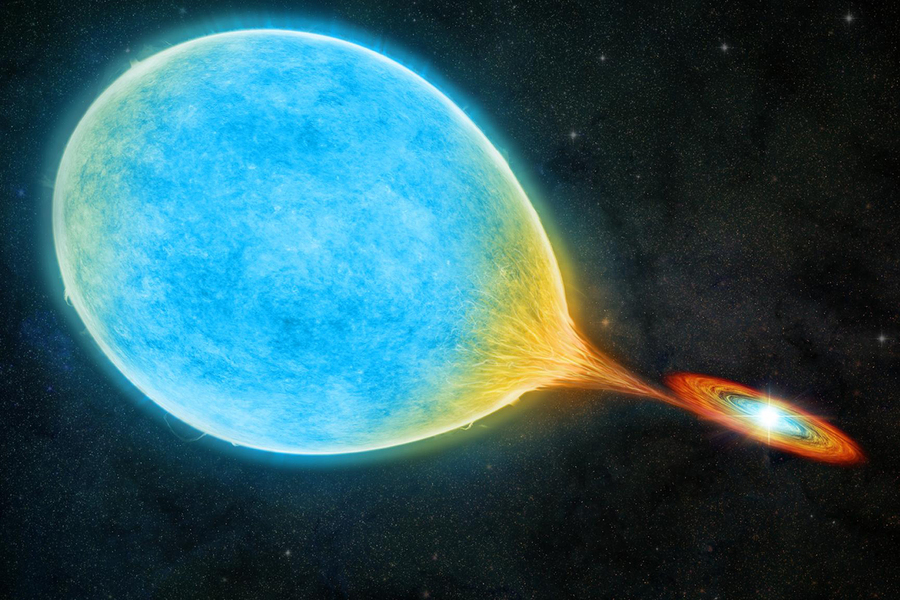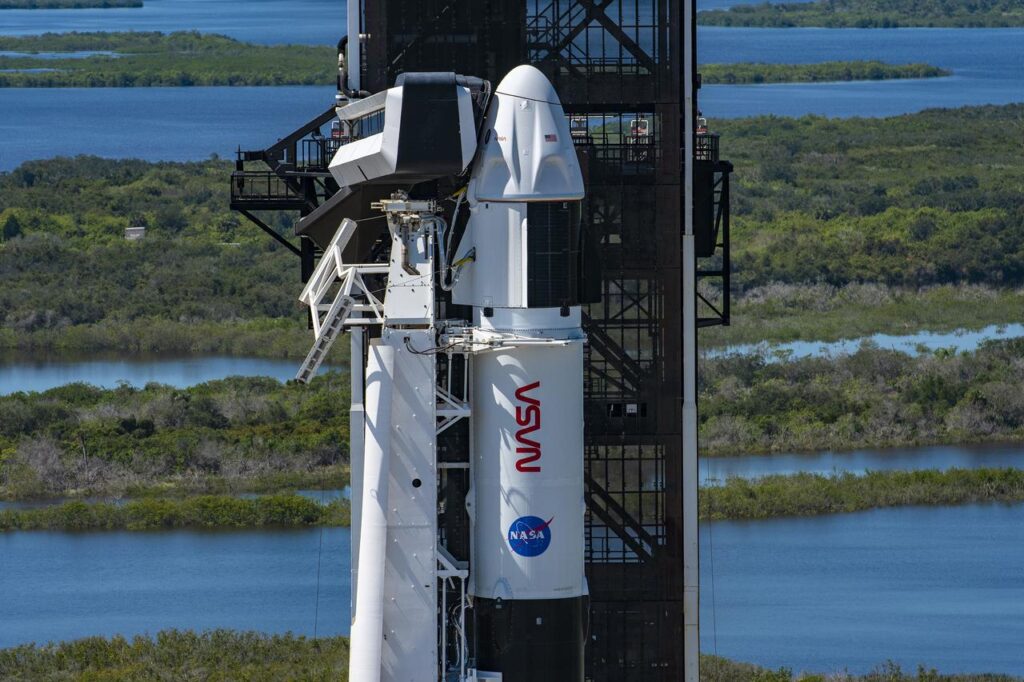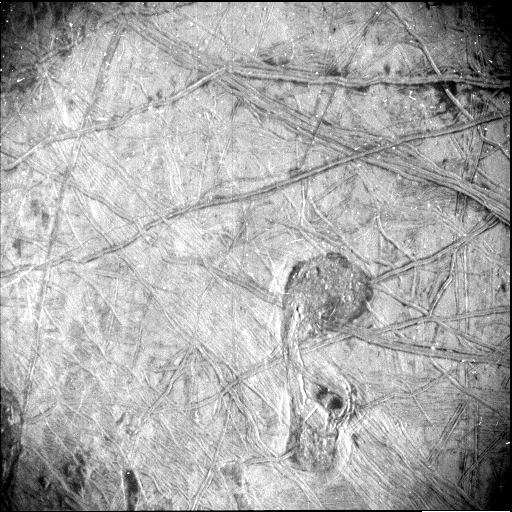While astronomers have observed white dwarfs consuming companion stars on numerous occasions, for the first time, they have now observed the consumption of the companion’s helium and not just hydrogen. Plus, galactic alignment, rocket launches including Crew 5, a new Europa image, and a review of the video game Tinykin.
Podcast
Show Notes
Observed: It’s a star-eat-star universe
- MIT press release
- “A dense 0.1-solar-mass star in a 51-minute-orbital-period eclipsing binary,” Kevin B. Burdge et al., 2022 October 5, Nature
Galaxies align when small, then flip out when combined
- Science in Public press release
- “The SAMI Galaxy Survey: flipping of the spin–filament alignment correlates most strongly with growth of the bulge,” Stefania Barsanti et al., 2022 August 26, Monthy Notices of the Royal Astronomical Society
ULA launches two satellites into geostationary orbit
- ULA press release
SpaceX launches four more humans into orbit
- NASA press release
SpaceX continues filling out the next phase of Starlink
- Starlink 4-29 mission page (SpaceX)
Europa seen in stunning detail by JunoCam
- NASA JPL press release
Transcript
Astronomy is a field of science with some of the most amazing imagery. From stunning views of worlds throughout our solar system to the latest JunoCam imagery of whatever it looked at today, astronomers are inundated with glorious data that describes a violent universe.
In today’s show, we have a dead star – a white dwarf – eating the atmosphere of its companion until that star is also dead. We have research looking at the results of galaxy collisions. We have science that documents a lot of destruction.
Beautiful destruction but destruction nonetheless.
And we also have some rockets, including yet more Starlinks.
All this and more today, here on the Daily Space.
I am your host, Dr. Pamela Gay
And we are here to put science in your brains.

One of the most satisfying things that an observational astronomer can do is capture the light of an object that theorists had predicted should exist, but no one has previously seen. And I am pleased to say a new group of observers – working with theorists – has just published a paper detailing the first-ever observations of two extremely close binary stars that are in the process of exchanging mass and changing identities.
This work appears in the journal Nature and is led by Kevin Burdge.
This team had a straightforward goal — find pairs of stars that very closely orbit one another, including elder stars in dangerous pairs, where one star is actively consuming its neighbor. Candidates were identified using the Zwicky Transient Facility (ZTF), which looks for things that flicker and flare in the night. One of these stars, cataloged as ZTF J1813+4251, was determined to have a 51-minute orbital period that was consistent with the larger star being deformed into something closer to an ellipsoid than a sphere.
This system appeared to be a pair of stars with the shortest seen orbit. The only way two stars can get this close – and still glow brightly – is if one object is a compact object like a white dwarf, while the other is a regular star that is having its atmosphere pulled off.
These kinds of vampiric systems have been seen many times, but in the past, we’ve only caught white dwarfs in the process of eating hydrogen from the outer atmospheres of their companion stars. According to theory, the white dwarf should keep eating its companion until it has consumed all the star’s hydrogen and even some of the helium that surrounds the stellar core.
But observers had never seen the helium-eating stage. Until now.
This team was able to get observing time on the Keck Telescope to acquire spectra of the system, along with high-quality images with the 10.4-meter Gran Telescopio Canarias. According to Burdge: This is a rare case where we caught one of these systems in the act of switching from hydrogen to helium accretion. People predicted these objects should transition to ultrashort orbits, and it was debated for a long time whether they could get short enough to emit detectable gravitational waves. This discovery puts that to rest.
In the coming millennia, the vampiric white dwarf will consume all accessible material from its companion, and as a result, nuclear reactions in the companion with shut down, and the helium-rich core will be left to shine as a new, very small, white dwarf.
And the vampiric white dwarf may light up as a new star if the mass it has consumed is sufficiently high.
This kind of identity switch is one of the cooler things binary stars can do, and it’s really awesome that we’re now seeing what theory had been predicting.
This is the perfect, Halloween season bit of science. I now want to see a binary star costume at my door, where the little dense object pipes up to say, “I’m a vampire.”

A lot of research is made possible thanks to surveys that have observed large regions of our sky to exacting standards. For ZTF, their standards are to take many shorter exposures that reveal what changes as they look for supernovae and other temporary events The Sydney-Australian-Astronomical-Observatory Galaxy Survey, or SAMI survey for short, has a very different purpose: it looks at how galaxies are aligned in space.
Our universe has a swiss cheese-like large-scale structure. Galaxies, in general, are found along the filigree walls and in the giant clusters where these walls come together. This structure is the result of slight density variations in our universe’s initial distribution of mass. Areas that had slightly more material were able to gravitational steal material from the slightly lower-density areas. This gradual flow of material is fairly well understood.
What had not been well understood is how these processes influence the formation of galaxies. At least it hadn’t been understood until now.
In a new paper in the Monthly Notices of the Royal Astronomical Society, researchers led by Stefania Barsanti studied how disk-shaped galaxies were aligned – or not – with the filaments of our universe’s large-scale structure. They found that systems with smaller central bulges tend to align their bulges rotation with the filaments, while systems with larger bulges tend to be perpendicular to the filaments.
It’s believed that galaxies – and their bulges – grow through collisions, and these observations imply that when two systems merge, the resulting galaxy’s bulge ends up perpendicular to the system.
These results add beautiful details to our understanding of how galaxies change as they merge. It really is a star-eat-star and galaxy-eat-galaxy universe out there.
And we’re here to explore it.
Coming up next, Erik brings us news on Rocket launches, and then we have a video game review from Beth Johnson.

This week was a major week for U.S. rockets, with four launched over the course of three days. Unsurprisingly, three of those were from SpaceX, but we also had a rare commercial launch from United Launch Alliance, carrying SES 20 and 21 on their way to geostationary orbit.
This launch was pretty unique; to understand why, here’s some background.
ULA was created in 2006 by a U.S. government order merging two companies’ rocket businesses. They launched all of the government’s satellites for almost a decade, receiving a billion dollars a year just to keep the pads ready, above the costs charged for individual launches. This arrangement made some of the other commercial launch providers in the U.S. upset, and this launch monopoly finally ended in 2015 after a series of lawsuits.
Mostly because of the higher costs, ULA has done very few commercial launches. Still, some customers chose them and continue to choose them for specific capabilities, like launching to certain high orbits.
SES 20 and 21 is one of these rare commercial launches. Several international satellite companies are working with the U.S. government to trade satellite bandwidth from one area to another so that ground-based 5G service can be rolled out to more of the US.
This involves launching expensive new satellites, but the government offered a monetary reward to those who were able to shift bandwidth before the end of 2023.
That’s where ULA comes in. The Atlas V 531 was able to deliver both satellites totaling 3.2 metric tons almost directly into geostationary orbit, shaving months off the time needed to get them into service. If they were put into a normal geostationary transfer orbit, the process would have taken six months just to raise the orbit because of the satellites’ low thrust xenon engines and even longer to test the satellite once in position.
This mission was the first commercial Atlas V mission to do a direct geostationary insertion, though Atlas V has done this for classified government satellites on several occasions.
After launching on October 4, the Centaur upper stage performed three burns over six hours to first get into orbit and second to raise the apogee of the orbit. Six hours later, it performed one final burn to circularize the orbit prior to deploying the satellites. Six hours instead of at least six months. That’s quick!
This mission marked the 154th ULA launch across their three rocket families and the fifth and final launch of the 531 variant.

The very next day, not quite setting an Eastern Range record, SpaceX launched four more humans into orbit en route to the International Space Station (ISS).
As always, Crew 5 launched from LC-39A at the Kennedy Space Center. This time, Crew Dragon Endurance launched on a brand new booster, 1077. This booster had a bumpy road leading up to launch – literally. On its journey to the SpaceX testing site in McGregor, Texas, the truck carrying it hit a bridge and damaged the rocket. SpaceX repaired and recertified it to NASA’s satisfaction, and the rocket continued launch preps.
The Crew Dragon assigned to Crew 5 was C210 Endurance, making its second flight carrying people to space. Its first was Crew 3, which landed on Earth in May 2022.
After the first stage separation, Booster 1077 landed on the droneship Just Read the Instructions. After spacecraft separation, the crew revealed what has become a standard, their zero-g indicator. This time it was a plush of famous physicist Albert Einstein.
Now let’s talk about those four humans.
The crew arrived in Florida last week after a slight delay due to Hurricane Ian. The four-member crew includes three rookies making their first flights to space, along with legendary JAXA astronaut Koichi Wataka. This is his fifth flight into space, after flying on Shuttle Discovery twice and Endeavour once. At the conclusion of his third mission, which saw him launched on Discovery, he returned to Earth on Endeavour. He became the first person to participate in five crews without returning to Earth: the shuttle he launched on, three ISS expeditions, and the shuttle he landed with.

His fourth trip to orbit was on a Soyuz during Expedition 38, which saw him become the first Japanese person to command the ISS. Cumulatively, he has spent almost an entire year out of the last twenty in space. At the conclusion of this mission, he will have spent almost a year and a half off the planet.
The other three members of the crew included two NASA astronauts: Nicole Mann and Josh Cassada. They were originally assigned to fly on the Boeing Starliner’s crewed flight test but were reassigned after repeated delays to that spacecraft.
This mission means Nicole Mann is the first Native American woman to go into space. Cassada holds a doctorate in physics and was a test pilot in the U.S. Navy. Both are from NASA Astronaut Class 21, all of whom have now flown in space.
The crew is rounded out by Roscosmos cosmonaut Anna Kikina. She is the only active female cosmonaut at Roscosmos and just the sixth Russian woman to go into space. And she is the first Russian to launch on an American spacecraft in twenty years.
Endurance is scheduled to dock with the ISS on the evening of October 7 and spend six months on the station. Crew 4 on Crew Dragon Freedom is scheduled to undock and return to Earth on October 12 after a five-day handover period.
Also on October 5, SpaceX launched their 45th mission of 2022, and you don’t even need to guess: it was another batch of Starlinks. This time, it was from SLC-4E at Vandenberg Space Force Base in southern California, which had its usual low-level marine layer obscuring the moment of liftoff. Once it cleared the clouds, however, the view was quite impressive.
Like the last Starlink mission, this launch used a relatively new booster, 1071, which had only flown four times previously. The booster successfully landed on the droneship Of Course I Still Love You. The second stage deployed 52 satellites into orbit 1 hour after launch following a two-burn profile.
Enough about rockets. Let’s switch to a review of a new video game.

Before I get to my review, I want to take a moment to share an amazing image of Jupiter’s moon Europa, taken by the Stellar Reference Unit (SRU) onboard NASA’s Juno spacecraft. On the way into perijove 45, or the 45th close flyby of Jupiter, Juno got closer to Europa than any spacecraft has since Galileo, and while JunoCam only took four images of the icy moon, Juno’s other instruments were hard at work, too.
Now, the most recent image release shows a small piece of Europa’s surface in fine detail, including double ridges, some darker stains, and a strange feature that looks like a musical quarter note. The image also shows white dots that are high-energy particles penetrating the surface. We’ll have a link to the press release in our show notes at DailySpace.org.
Juno’s next Galilean moon flyby will be Io in 2023, and these most recent images of Europa will likely be the best ones we have available until Europa Clipper arrives in the early 2030s. For now, though, we have some pretty awesome data coming from the Juno mission.
And now, a review.
Review

It’s not often that we review video games around here… mostly because there haven’t been a lot of new releases we feel are appropriately themed for our community. That all changes today.
In my neverending quest for activities that aren’t work, I recently signed up for PC Game Pass on Xbox. I confess that the original motivation was to play Disney Dreamlight Valley without dropping $30 on a game that is essentially in beta. (If you want to learn more about that particular game, ask me in Discord sometime.) When I reached the max of what was available in Dreamlight Valley, I started asking some online friends for Game Pass recommendations.
And someone on Urban Bohemian’s server mentioned a game called Tinykin. Their description intrigued me as they said: Tinykin is super cute. Hard to explain what kind of game it is. But a lot of ‘do this to unlock that’. And then you can get this thing. I’d best describe each level being a Rube Goldberg machine if you like that kind of puzzle-type thing. There are also collectibles and side quests, so quite a bit to do.
So I downloaded the game and fired it up. The story starts with a character named Milo. In the far future, Milo lives on a planet that is not Earth but where everyone says that they are the first humans. He doesn’t agree, so he sets off to find humanity’s origin planet, and he does! But when he arrives, something is wrong – he’s the size of a penny, and somehow, it’s the 1990s.
From here you deal with all the bugs, so if that is a thing that will bother you, you have been warned. The bugs have built a thriving civilization in a house, and it’s basically a giant obstacle course. The first bug you encounter is Ridmi, and he’s trying to build a suit for which he needs a bunch of parts from around the house. You basically collect them one room at a time, and you learn new skills with each room.
The biggest part of those skills lies within the title creatures – Tinykin. Apparently, they never did anything until Milo came along, and now they are his helpers. Ridmi has a cool method for teaching you how to use them. So far, I’ve been trained to use strong Tinykin that can move large objects in a group like ants, fire Tinykin that blow themselves up and light things on fire, and stacking Tinykin that become ladders for Milo to climb when the next point is too high for him to jump.
Each room has a main quest to acquire the part Ridmi needs and then a few subquests to acquire artifacts for another character. There’s also pollen you collect to get better and better glider bubbles. Milo can jump, use a bar of soap as a skateboard, and float down in a bubble. As you gain glider bubbles, you can glide longer distances.
The game is just adorable. I love the Tinykin and Milo and even the bugs are cute. The mechanics are simple, but they require some hand-eye coordination, and yes, it’s a lot of ‘do this to do that’ puzzles. I had to use a walkthrough guide on the first room because I was missing something… which turned out to be rather obvious when I read it. For the second room, I made it through everything without any outside help. That felt pretty good.
Oh, and I should mention that the quest in the first room involves the need to put a CD in a CD player… and the band’s name is The Tardigrades. I cannot wait to see what kind of role they play in later rooms because tardigrades are awesome.
Overall, I give this game a solid “go out and play it if it’s your thing”. I’m enjoying it and struggling to not just play the entire game through in one sitting.
Tinykin was developed by Splashteam and published by Tiny Build. It’s available on PC, PS4, PS5, Xbox One, Xbox Series X|S, and Nintendo Switch. We received no compensation for this review, and all Game Pass subscription fees were paid for by me.
This has been the Daily Space.
You can find more information on all our stories, including images, at DailySpace.org. As always, we’re here thanks to the donations of people like you. If you like our content, please consider joining our Patreon at Patreon.com/CosmoQuestX.
Credits
Written by Pamela Gay, Annie Wilson, Beth Johnson, Erik Madaus, and Gordon Dewis
Hosted by Pamela Gay, Beth Johnson, and Erik Madaus
Audio and Video Editing by Ally Pelphrey
Content Editing by Beth Johnson
Intro and Outro music by Kevin MacLeod, https://incompetech.com/music/


 We record most shows live, on Twitch. Follow us today to get alerts when we go live.
We record most shows live, on Twitch. Follow us today to get alerts when we go live.